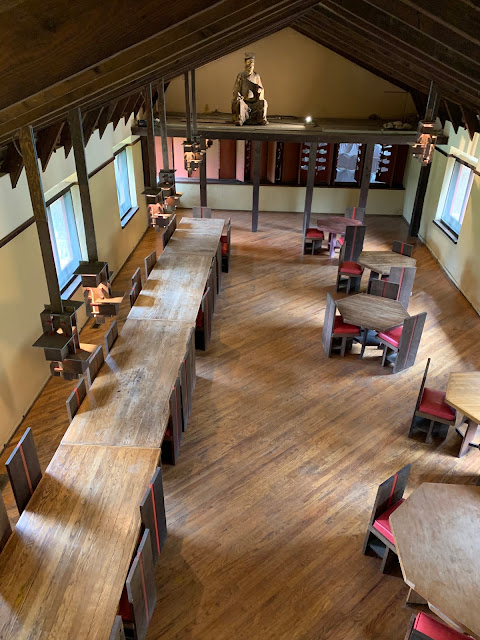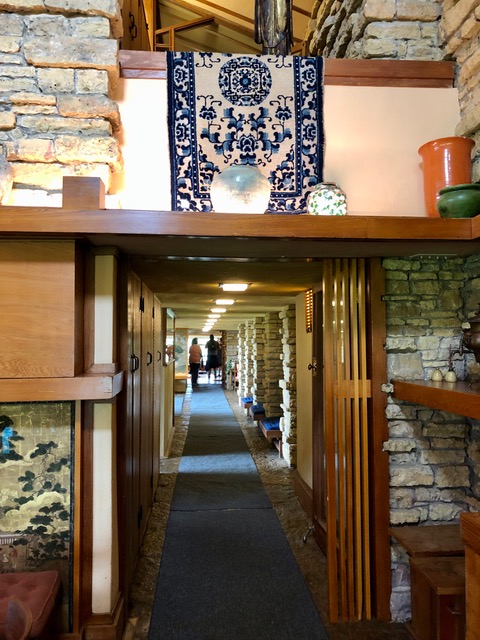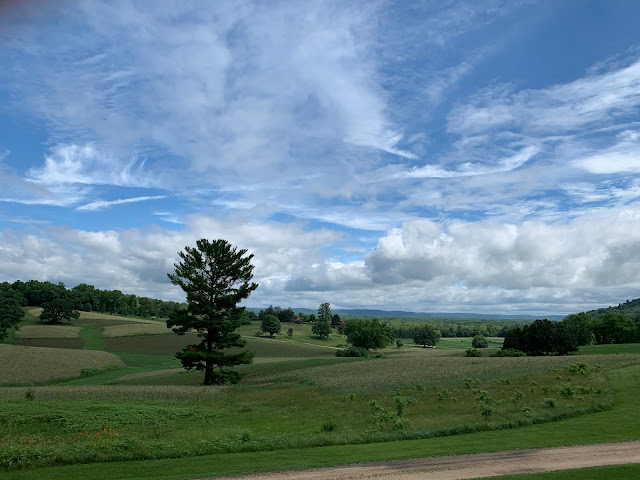THE WAY OF BEAUTY
 |
| The main residence sits below the brow of the hill. The section you can see jutting out was a viewing platform for his wife to see the birds. There were more trees around it at the time. |
 |
| Rear entrance to the main residence |
When I first saw a Frank Lloyd Wright building, one of the early ones that incorporated his revolutionary designs and was built at a time when horses were more common than cars, it took my breath away. It was out of time, an anachronism, like seeing a Tesla in 1950. The fact that the wood was aged, edges marred or peeling, had me imagining a new building that had been made with old, used materials.
 |
| Dining hall of what was the Hillside Home School, a boarding school built in 1932, later his architecture school. The chairs are as uncomfortable as they look. The furnishing are made of plywood. |
 |
| Once the entrance for horses and carriages, modifed for cars. A signature color was red, and cars at Taliesin needed to be dark red. |
 |
| In the main residence. Plywood again, but beautiful this time. (I don't know about comfort.) The Japanese influence can be seen in the painting that is reflected beautifully in the glass table top. |
This, from a 2009 New York Times book review:
Frank Lloyd Wright was a visionary who produced some of the 20th century’s grandest architectural designs. He was also a reckless adventurer who got lucky. He liked to position structures over waterfalls, on steep slopes, at the bottom of arroyos. He designed a hotel that withstood a major earthquake. He designed private houses marred by leaking roofs and poor heating systems. He rewarded his clients with buildings that suited their needs. He ignored his clients’ wishes and didn’t pay his bills. He was devoted to his art. He would let nothing stand in the way of success. He was passionate and affectionate, manipulative and denigrating. By all accounts he loved — and hated — publicity.
He designed his country estate, Taliesin, in Wisconsin, as a retreat where he could live — and love — in peace. Taliesin was where he went to escape the press. It was where he gathered with his apprentices and worked for long stretches. And it was where he brought his mistresses and wives.
He did love plywood, used it everywhere, and in several rooms it shows its age. And it’s probably no surprise to anyone who has visited a Wright-designed place (“place” often includes not just the building, but everything inside of it, chairs, lamps, tables, placement of ceramics, etc.) that the chairs are often uncomfortable, unforgiving. (Yes, we were allowed to sit.) Design über alles, my ideas over yours.
 |
| Wright designed the entire farm as well. The silos are low because he felt tall silos would mar the overall design. |
 |
| Wright's office in the main house |
 |
| Rooms were added and changed many times. A bedroom had 21 (!) ceiling revisions. |
Apprentice architects or interns–perhaps acolytes is a better word–were expected to work on the farm, the house, and elsewhere on the estate. They were the ones who physically built nearly everything. Some had had enough after a month, others stayed for a lifetime.
 |
| Drafting room for apprentices/interns/acolytes. They sat on the little slanted stools. The room was heated by a fireplace at each end. |
I’d visited Taliesin West in Arizona where the Wright entourage migrated in winter and have seen other Wright houses, but this is the one where his life was mostly lived. It was a tumultuous life. Three wives, a liaison that ended in tragedy: a servant butchered his then partner, Mamah Cheney, her two children who were visiting, and a colleague after having locked the doors and set the house on fire.* This was the second and worst fire to happen here, the earlier one caused accidentally by poor wiring. Wiring was not one of his strong points.
 |
| Much of Wright's work was inspired by Japanese architecure which he admired. |
THE WAY OF IMPORTANCE
 |
| The Capitol building in Madison, WI as I saw it. |
 |
| Capitol building, as I did not see it. Construction began in 1837, completed in 1917. Cost: A whopping $7.2 million. |
Just up a slight rise and two blocks from the hotel I could see the what appeared to be the main entrance to the humongous Capitol building. Walk on the street toward that entrance and take a right, and there it is again, or what looks like the same entrance. Keep doing that, twice more, squaring the circle, and you will see it has four identical entrances, four streets cutting diagonally across the grid to take you there, as if it were the sun, orbited by everything else, on the highest piece of land, a strip between two lakes. The Capitol Building of Madison, the capital of Wisconsin, has a layout that has been seriously designed. Imagine L’Enfant inn 1791 laying out the center of Washington, D.C. but on a much smaller scale. You can do that when you’re starting a city, or a state for that matter, from scratch.
 |
| Only the best materials. |
 |
| All of it is pretty impressive. |
Some “scratch.” It’s not as if the land was just there. The local (Ho-Chunk tribe) had to be removed, or ideally, disappeared in some way,* after which the city was pretty much created by smoothing over the original ancient native mounds and adding more soil where it was needed, along with rerouting some water. But, really, how different are the stories of other cities, other states? It was James Duane Doty (1799-1865), land speculator and politician–a useful combination then as now–who drove the process, named the place, laid out the square and streets, with his purchase of 1,261 acres–not from the Ho-Chunk of course, but the government–for $1,500. It was for him a start on the road to riches.
 |
| "X" marks the spot, literally. (Capitol building) |
 |
| The almost-always-visible state Capitol as seen from Manona Terrace designed by Frank Lloyd Wright. |
AND A MASH-UP
Wright’s influence is noticeable here and there around Madison. The house below, however, says importance much more loudly than it says beauty.
 |
| Home for sale, Madison area, $1.695,000. It's giantism is hidden behind the front view. |
BUILT TO LAST?
 |
| The so-called Romeo and Juliet towers, originally built as a windmill in the late 1880's for the Hillside school looks old, but was actually demolished and rebuilt in 1992. |
 |
| Behind the ferns at right is scaffolding holding up the not-yet-rehabbed apartment where Minerva, 97-year-old former assistant to Wright's wife Olgivanna, still lives. |
Every building needs repairs from time to time. Wright’s buildings may need it more than most. I didn’t take a photo of crumbling stone steps (in an used entry way, as it happened), but their appearance suggested other stone steps had been in need of help. After his third wife Olgivanna died in 1985 and the Foundation took over the estate, major rehab was required. It is still underway and may continue to be, in perpetuity. The Capitol, obviously, is made of sterner stuff. (Although it, too, was rehabbed or "restored" in the 1990's.)
But which is really more important?
NOTES
*A fictionalized version based upon actual events is engrossingly told by T. Coraghessan Boyle in “The Women,” published in 2009.
**Chief Black Hawk was both Sauk and Ho-Chunk. The story of the Black Hawk War is a complicated one. It marked the end of Native American armed resistance to U.S. expansion into what came to be called the Northwest Territories. Here’s an irony for you: According to University of Wisconsin historian Kerry Trask (credit: Wikipedia), after their defeat, “Black Hawk and his fellow prisoners were treated like celebrities because the Indians served as a living embodiment of the ‘noble savage’ myth that had become popular in the eastern United States. Then and later” argues Trask, “white Americans absolved themselves of complicity in the dispossession of Native Americans by expressing admiration or sympathy for defeated Indians like Black Hawk.”

